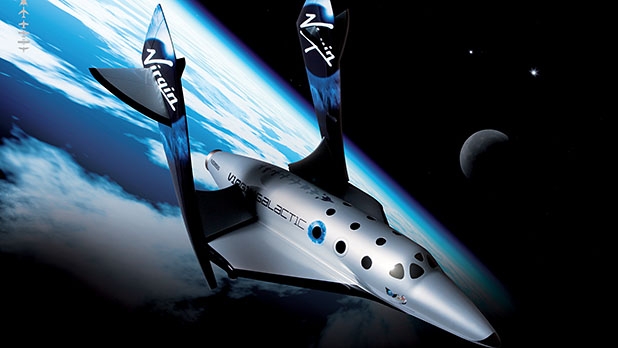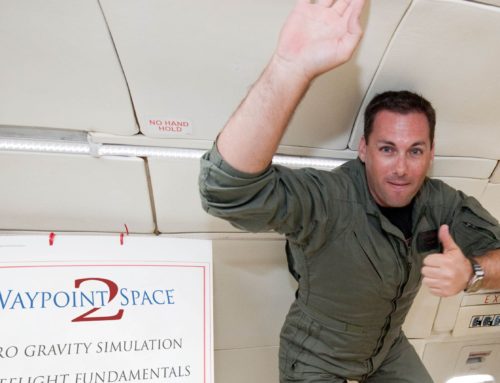Virgin Galactic
Once a week at dawn, C.J. Sturckow guns a blue Extra 330SC stunt plane into the pink sky above the Mojave Desert. At 14,000 feet, the 5-foot-9 former NASA astronaut starts doing his “card” – a checklist of rolls and spins meant to simulate spaceflight’s G-forces. White-knuckling the plane’s joystick, he exerts nearly six G’s on his body, enough to drain the blood from his brain until he nearly “grays out.” “When I first started doing it,” he says in a Texas accent, “it was a little nauseating.”
RELATED: Top Five Commercial Space Travel Companies
Getting used to the G’s is part of the top-secret training Sturckow, 52, is undergoing at Virgin Galactic’s remote facility in Mojave, California. For years, Virgin airline’s billionaire founder, Sir Richard Branson, has been payrolling a 255-person crew of the world’s top pilots, engineers, physicists, and designers to produce the first commercial space line – and he isn’t alone. At least nine global companies are working to offer private spaceflight, and they are attracting a growing number of NASA astronauts and technicians now that the U.S. shuttle program has closed. But no company has received the scrutiny of Virgin Galactic, with a blond-maned founder who has been making headlines for his celebrity passenger list (Angelina and Brad), the exorbitant ticket price ($250,000), and the constantly delayed launches (he recently said the first flight would take place on this coming Christmas Day, before pushing it back yet again). But while Branson has claimed for nearly a decade now that he is this close to sending tourists into space, he finally seems to be ready. In September, Virgin Galactic rocketed its VSS Enterprise higher and faster than ever before – the ship flew 69,000 feet into space, breaking the sound barrier before gliding back to Earth. Afterward, Branson stated that the launch is “on track for 2014.”
On paper, the Enterprise’s flight is straightforward. The ship is strapped beneath a twin-fuselage jet, flown up to nearly 50,000 feet, and dropped. It then turns on its rocket and soars straight up at 2,800 miles per hour to 68 miles above Earth – the very edge of what we call space. After a few minutes in suborbit, it falls back to Earth, using a patented feathered-wing system – the wings on the tail rotate 65 degrees, allowing the plane to fall like a giant shuttlecock. The whole trip lasts two hours, with four minutes of weightlessness at the top of its arc.
Yet Virgin Galactic’s delays hint at a more difficult story. “Don’t believe anyone who tells you the safety will be the same as a modern airliner’s,” former spaceship designer Burt Rutan said during a 2008 press conference, stating that the Enterprise is “progressive,” on par with “the early airliners in the 1920s.” Contrary to NASA images of peaceful, bouncing astronauts, floating in space is chaotic. Also, reentry into Earth’s orbit pushes up to six G-forces on passengers, potentially causing blackouts. And the fashion-conscious Virgin has chosen to have passengers wear helmetless flight suits – a possible gamble should the ship lose pressure in the oxygen-free cosmos.
But if anyone stands a chance of overcoming these obstacles, Branson is betting it will be his team. Sturckow and Virgin Galactic’s head pilot, Dave MacKay – a 56-year-old former RAF fighter pilot – are working out the kinks so that Branson may soon board. “A key design philosophy was to keep it as simple as possible, the theory being that a streamlined system reduces the probability of failure,” MacKay says. “We think the chances of things going wrong are really low, but yes, there are risks.”
The Virgin Galactic crew works in a cluster of unmarked hangars comprising 170,000 square feet at the edge of the Mojave Air & Spaceport – a sandblasted site where companies rent airfields to test experimental aircraft. Standing out amid the rocket engineers and physicists in his vintage Hugo Boss dress shoes, industrial designer Adam Wells, 35, is crafting the Enterprise’s interior, flight suits, and spaceport. “We’re defining the product,” Wells says in a British accent. “We’re going to have fun.” While the Enterprise is being constructed and tested in Mojave, it will ultimately fly with passengers from the Spaceport America outside Las Cruces, New Mexico – an empty building Wells is currently designing.
For maximum drama, arriving passengers will file up a long ramp to Spaceport America. Steel doors will automatically open onto the astronaut lounge, a three-story room with a wall of windows facing the spaceport’s two-mile-long runway. “Richard gives tremendous attention to the emotional experience of flight,” says Blair LaCorte, a former CEO who signed up as Enterprise passenger number 197. “It’s like, ‘Let’s get the blood flowing and really feel it.’ ”
Already, 630 people have bought tickets to fly aboard the Enterprise once it launches. These early adopters are invited to periodic events hosted by Virgin Galactic – debriefings at Branson’s own Necker Island, flight tests at Mojave, and training on a Philadelphia-area centrifuge to ensure they can handle the flight’s massive G-forces. Surprisingly, only a few of the Enterprise’s passengers have not been able to complete the challenges, mostly due to blood-pressure issues. It’s an impressively low number considering many of them are hard-charging business people in their 50s and 60s who “partied hard when they were younger,” according to Julia Tizard, an astrophysicist who is Virgin’s director of operations. At the spaceport, passengers will spend three days undergoing medical checkups with NASA-trained doctors, learning how to fly in zero gravity and getting briefed on the mission. “You’re basically a speeding bullet,” Enrico Palermo, a Virgin vice president of operations, says about the flight intensity. “You’re going faster than most humans ever will.”
While the ride up can be terrifying, Brian Binnie – the astronaut who piloted the Enterprise’s prototype – says a few moments in space are worth it. “There’s this magic moment when the motor shuts down and it gets quiet,” he says. “I call it the karma of weightlessness. You see mountain ranges, weather patterns, and the thin electric-blue ribbon of the atmosphere.”
The ship is on an arching trajectory, and this moment is the apex of the roller coaster. After floating for about four minutes, the Enterprise will fall back to Earth with up to six G’s of force. The seats recline to 180 degrees to help passengers absorb the forces – although not everyone may be strapped in. “If you’re slow, then at some point you just settle down on the floor,” Binnie says, adding that reentry is deafening. “It’s like driving into a rainstorm – the first few sounds are sporadic, then they build into a shower and finally become a thundering Niagara,” he says. “At nearly six G’s, it sounds like a tornado has invaded the cabin.”
Virgin’s decision to have helmetless flight outfits instead of pressurized space suits with oxygen feeders may be an added risk. “If an aircraft at 30,000 feet loses pressure, it descends to 20,000 feet, where there is oxygen in the air,” says Brienna Henwood, a National Aerospace Training and Research Center representative. “A spaceship at 330,000 feet can’t do that. It’s a risk.” But Virgin considers space suits unnecessary – for now. “We have always been clear that a shirt-sleeve environment was part of the baseline design,” Virgin commercial director Stephen Attenborough says. “However, safety remains the priority, and should any new factors emerge that mean we should change that or any other element, then of course we will do so.” Binnie says if the Enterprise has a “serious structural issue” in space, “residual compressed air” would flood the cabin with oxygen until the ship descends to a denser atmosphere. “Also, everybody will have these little scuba bottles like James Bond has in ‘Thunderball,’ ” he says. “They’d be good for a few minutes, and that’s all you need.”
In the entire half century since manned space flight began, only 531 people have gone into space. Virgin hopes to surpass that number within the next two years. To reach its stated goal of twice-a-week flights, Virgin will ultimately build two more mother ships and four more space planes. It already has a $1.5 billion contract to deliver payloads for NASA to the International Space Station. And Branson plans for his high-flying spaceships to one day offer fast service from one side of the planet to the other, cutting down travel time on itineraries like Sydney to New York to a few hours. Given Virgin America’s current financial problems – the company posted a $37.5 million loss for the first half of 2013 – Branson may be betting on the future of space travel.
For his part, Virgin pilot MacKay is ready to blast off; despite flying the rocket ship, he has yet to visit space himself. “This is the pinnacle, really,” he says. “To take a vehicle up to 50,000 feet and drop it from another one and then light a great big rocket motor and go up into space – I can’t think of anything more exciting.”
By: Kevin Gray
To view the original article CLICK HERE


